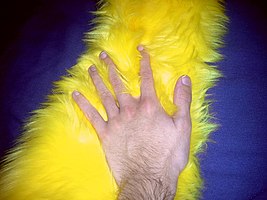Stimming

Self-stimulatory behavior, also known as "stimming"
Stimming has been interpreted as a protective response to overstimulation, in which people calm themselves by blocking less predictable environmental stimuli, to which they have a heightened sensitivity.[2][3] A further explanation views stimming as a way to relieve anxiety and other negative or heightened emotions.[4]

Although some stimming behaviors have been shown to be healthy and beneficial—as they help regulate intense feelings—
Stimming behaviors can consist of tactile, visual, auditory, vocal, proprioceptive (which pertains to limb sensing), olfactory, and vestibular stimming (which pertains to balance). Some common examples of stimming (sometimes called stims[10]) include hand flapping, clapping, rocking, blinking, pacing, head banging, repeating noises or words, snapping fingers, and spinning objects.[11][12] In some cases, stimming may be dangerous and physically harmful to the person doing it; for example, individuals may risk injuring themselves by forcefully banging their body parts against walls.[13]
Stimming and autism

Stimming behavior is almost always present in
Different perspectives suggest that stimming involves both sensory and motor functions. Underdevelopment of these sensorimotor functions can result in stimming behaviors produced by the person as a controllable response. One study which interviewed thirty-two autistic adults found that unpredictable and overwhelming environments caused stimming.[16]
Stimming can sometimes be
As it serves the purpose of self-regulation and is mostly done subconsciously, stimming is difficult to suppress.[18] Managing the sensory and emotional environment while increasing the amount of daily exercise can increase comfort levels for the person, which may reduce the amount of the need for stimming.[19] Consciously or subconsciously suppressing stimming with the aim to present as neurotypical is one type of autistic masking.[20][21] It typically requires an exceptional effort and can negatively impact mental health and well-being.[20][21][22]
See also
References
- ISBN 978-0-85700-872-5.
- ^ ISBN 978-1-4587-9728-5.
- ^ ISBN 978-1-84642-042-9.
- ^ Eileen Bailey (15 July 2011). "Autism Spectrum Disorders and Anxiety". Health Central. Retrieved 25 March 2014.
- ^ S2CID 240532683.
- ^ S2CID 244869197.
- PMID 30818970.
- PMID 35781855.
- S2CID 261679577.
- ^ Temple Grandin, PhD (November 2011). "Why Do Kids with Autism Stim?". Autism Digest. Archived from the original on 31 March 2014. Retrieved 25 March 2014.
- ^ Eileen Bailey (27 August 2012). "Stimming". Health Central. Retrieved 25 March 2014.
- ^ "Stimming: What autistic people do to feel calmer". BBC. 5 June 2013. Retrieved 25 March 2014.
- ^ Smith, Lori; Legg, Timothy J. (19 February 2018). "What is stimming?". Medical News Today. Retrieved 19 April 2022.
For some, stimming can include higher-risk behaviors such as banging their hands, head, legs, and objects, which may be potentially physically harmful.
- ^ About.com. Archived from the originalon 30 March 2014. Retrieved 24 March 2014.
- )
- PMID 30818970.
- S2CID 54224210.
- ^ Devita-Raeburn, Elizabeth (10 August 2016). "The controversy over autism's most common therapy". Spectrum News. Simons Foundation. Retrieved 7 April 2023.
- PMID 19122856.
- ^ PMID 36601266.
- ^ PMID 28527095.
- ^ "6A02 Autism spectrum disorder". icd.who.int. ICD-11 for Mortality and Morbidity Statistics. 2022. Retrieved 7 April 2023.
